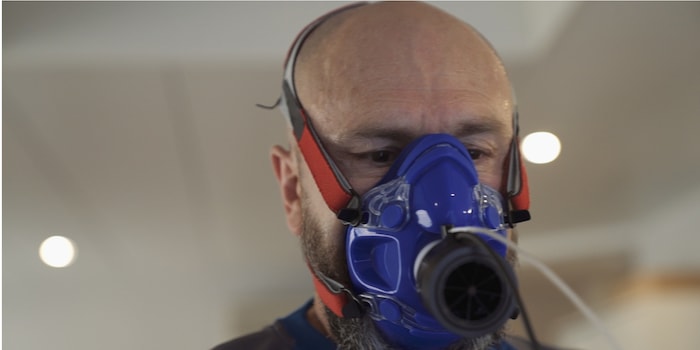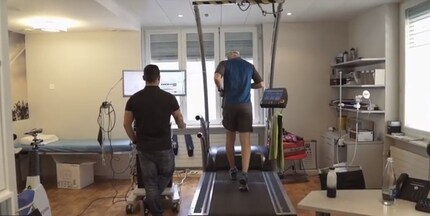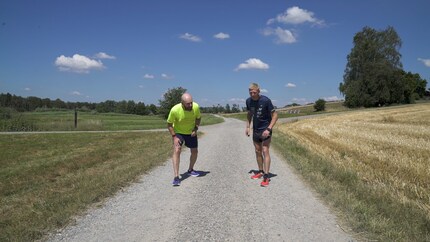
Background information
To the limit and beyond - a performance test that speaks volumes
by Patrick Bardelli

A performance test shows where you stand in terms of sport and what you need to focus on in training in order to achieve the desired performance. Which measurement methods are suitable for whom?
You are sporty and enjoy exercise. But you are also ambitious, want to improve, become faster or run more light-footedly. Athletes want to know where their strengths lie, but also what their weaknesses are and how they can improve them.
A performance test shows your current sporting level. Most test procedures for endurance athletes involve defining the individual anaerobic threshold. This serves as a starting point for grading the individual training zones. In practice, it therefore makes sense for runners to check the results of a performance test in the first few weeks after a test if possible. A 30-minute tempo run at the determined threshold is a good way to do this. If you cannot maintain the threshold pace over 30 minutes, the threshold, or the stages derived from it, is set too high.
Whether indoors in the lab or outdoors: The important thing with performance tests is that they are as standardised as possible and are always carried out under the same conditions. This is the only way you can ultimately make a meaningful comparison. And only the individual progression of test results under the same conditions provides information on whether the sports training is bearing fruit. Below you will find the most important test procedures for runners that can be carried out by professional suppliers:
Execution: Running field test on a circular track. The test subjects run individually or in groups of up to 20 participants from marker to marker (every 20 metres) on a 400-metre track. The next checkpoint must be reached at each beep. The runners start at a speed of between eight and 14 kilometres per hour, depending on their performance level, with an increase in speed of 0.5 kilometres per hour every 200 metres. The heart rate is measured at each speed level and at maximum power.
Statement: Determination of the anaerobic threshold with conclusions about the training zones. Only suitable as a progression test to a limited extent, as external factors such as wind etc. influence the accuracy of the test.
Advantage: Simplicity, simultaneous testing of groups possible.
Disadvantage: Stages too short for the heart rate to stabilise. Test evaluation only by means of heart rate curve. The evaluator's experience and prior knowledge of the athlete's performance is crucial for the assessment. Influenced by weather conditions as a field test.
Conclusion: For groups, young athletes, amateur athletes and students who are looking for a cheap entry-level test.
Costs: Inexpensive, usually less than 100 francs. Easy to organise at schools/universities or for clubs.
Execution: Run with stages lasting three to six minutes. There is a 30-second break between the speed levels to take blood for the lactate measurement (finger, earlobe). The intensity is gradually increased until the individual maximum performance is reached.
Statement: Good method for determining the lactate thresholds and thus the individual anaerobic threshold, which allows the current training status to be analysed and the heart rate zones of the training zones to be defined. Good progression test for assessing performance development.
Advantage: Laboratory test with high standardisation and reproducibility of results. Can be performed for specific sports (running, cycling on ergometer or cycle ergometer/roller).
Disadvantage: Short step lengths of around three minutes are not enough to achieve the lactate steady state. Partial coordination problems for runners who are not used to running on a treadmill, especially at high speeds. Also, the speed on the treadmill cannot be transferred to the terrain. Fast tempos are easier to run on the treadmill due to the lack of foot push-off movement, which is why an incline of around one per cent is often set.
**Conclusion:**The effort is justifiable. The test takes around 90 minutes. Suitable for anyone who wants to train according to their heart rate. Important: maximum load required = maximum test. Repeat the test after around two months or in the following year at the same time of the season as a follow-up test.
Costs: Around 250 francs

Execution: Step protocol analogue to the lactate step test, 30-second pause during the treadmill step test for blood sampling. Intensity is gradually increased up to the individual maximum performance. Breathing through a mask on a flexible tube to determine the gas composition in the inhaled and exhaled air.
Statement: Allows the training zones to be calculated using both so-called ventilatory thresholds and the lactate curve. Precise method for determining the maximum oxygen uptake (VO2 max / VO2 peak) as an important assessment of potential endurance performance. This makes it a good screening test for endurance performance or for assessing the potential of a young athlete.
Advantage: Laboratory test with various measurement parameters, considered the most accurate test in performance diagnostics. Information on exercise economy possible by comparing oxygen uptake capacity over the course of the same exercise (running speed). Possibility of assessing endurance performance capacity using reference values for various sports. Also used for medical tests.
Disadvantage: Short step length, not very sport-specific. Also associated with higher technical and equipment costs. Subject has to breathe through the mask, which is not tolerated equally well by everyone and causes coordination difficulties, especially when running, as the field of vision is also restricted.
Conclusion: Demanding test, lasting around 90 minutes. Suitable for ambitious competitive athletes. As with the lactate level test, it makes sense to repeat the test after around two months or in the following year. Little added value compared to a high-quality lactate level test.
Costs: Around 350 francs
Implementation: Similar to the Conconi test, the field test is usually carried out on a circular track. The step length is 1000 metres with a break of two minutes between steps. The test subjects start individually or in groups at freely selectable intervals. The athletes are instructed to cover the distance four times at different intensities: easy, medium, fast and full.
Statement: Good indication of the subjective feeling of exertion of the test subjects, under certain circumstances incorrect training behaviour (training in the wrong areas) can be shown. Training recommendations can be made for appropriately selected running intensities. Can also be used as a progression test.
Advantage: Several test subjects at the same time, low effort and costs. Can also be carried out without lactate.
Disadvantage: Informative value depends heavily on self-assessment ability and body awareness (choice of running intensity) as well as on the way the test is carried out and the external conditions.
Conclusion: Very good introductory test or for testing teams/clubs.
Costs: Depending on the size of the group, around 100 francs per person.

In contrast to laboratory tests, field tests usually take place outdoors and can be completed by yourself with a little routine.
Field tests serve as an important assessment of competition-specific performance and should be as sport-specific as possible: The runner on the treadmill, the cyclist on the ergometer, cross-country skiers on skis, swimmers in the water and mountain bikers on the bike. Each athlete is therefore travelling in their own sport and the corresponding environment. For the short-term prediction of a competition performance, field tests are usually more meaningful than laboratory tests, but with the caveat that the environmental conditions cannot always be influenced and kept the same.
The factors to be influenced in a field test should be as standardised as possible. For example, always choose the same test round or carry out the test in a recovery week after two days without major training stress and in good health. When it comes to determining the anaerobic threshold, a 30-minute test already provides a good basis for determining this. This is because you normally run at maximum and constant effort for 30 minutes at around your threshold.
When it comes to estimating the time for a target race, the distance of a test lap should be tailored to the target race distance and cover around 50 to 70 per cent of the target distance. For a 10-kilometre performance, the test lap would therefore be around 20 to 30 minutes long. For a marathon test, the half-marathon distance or a 25-kilometre run and so on. The chosen distance should be run at a constant, maximum possible pace.
In addition to the finishing time or average pace, you can also use the heart rate and subjective feeling of exertion (Borg scale) for assessment in a field test. And even lactate measurements are possible with a little know-how and a lactate meter.
From radio journalist to product tester and storyteller, jogger to gravel bike novice and fitness enthusiast with barbells and dumbbells. I'm excited to see where the journey'll take me next.
Practical solutions for everyday problems with technology, household hacks and much more.
Show all